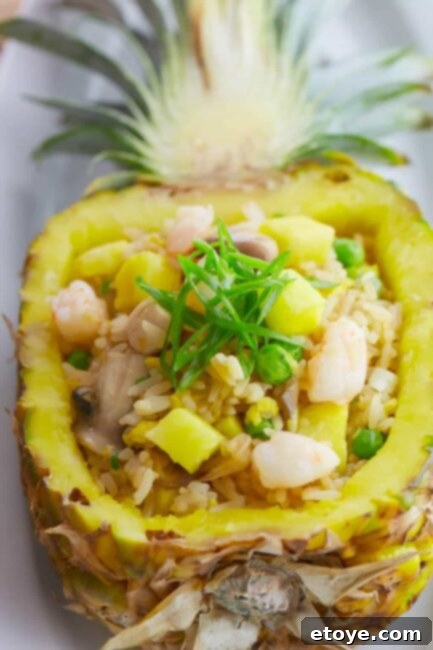The Ultimate Guide to Perfect Pineapple Fried Rice: Fluffy, Flavorful, and Never Soggy!
Are you ready to transform a simple weeknight meal into an exotic culinary adventure? Pineapple Fried Rice, a beloved dish originating from Thai and Southeast Asian cuisine, is celebrated for its delightful balance of sweet and savory flavors, tender meats, and the vibrant tang of fresh pineapple. However, many home cooks struggle with achieving that coveted restaurant-quality, fluffy texture, often resulting in a heavy, sticky, or even soggy outcome. This comprehensive guide is your essential resource to mastering the art of Pineapple Fried Rice, ensuring every grain is distinct, every ingredient perfectly cooked, and the presentation utterly breathtaking.
In this in-depth guide to crafting the most delicious Pineapple Fried Rice at home, you will discover essential techniques and expert tips that guarantee a spectacular outcome. We’ll walk you through crucial steps, from preparing your rice to perfectly cooking each ingredient, and even how to turn a whole pineapple into an impressive serving vessel. Say goodbye to soggy, heavy, goopy fried rice and embrace a light, fluffy, and incredibly flavorful dish that will impress family and friends alike!
What You’ll Master in This Pineapple Fried Rice Guide:
- Preventing Soggy Fried Rice: Unlock the secrets to achieving perfectly fluffy, light, and distinct rice grains, free from stickiness or excessive moisture, a common pitfall in homemade fried rice.
- Effortless Pineapple Preparation: Learn a simple, step-by-step method for expertly cutting a whole pineapple and transforming it into an elegant, edible serving bowl for an unforgettable and visually stunning presentation.
- The Art of Separate Cooking: Understand why cooking specific ingredients individually is paramount to maintaining their unique textures, flavors, and ensuring optimal doneness, resulting in a perfectly balanced Pineapple Fried Rice.
The Foundation of Fluffy Fried Rice: Why Leftover Rice is Non-Negotiable
The quest for truly great fried rice begins not with the stir-frying, but with the rice itself. One of the most common pitfalls home cooks encounter is using freshly cooked rice. While it might seem convenient, hot, freshly steamed rice is laden with moisture, and its starch molecules are fully gelatinized, making it incredibly sticky. When introduced to a blazing hot wok with additional ingredients and liquids like soy sauce, this fresh rice will inevitably clump together, absorb too much moisture, and transform into an unappetizing, glue-like mush. This results in a heavy, goopy texture that is the absolute antithesis of perfect, airy fried rice.
The culinary secret lies in utilizing **leftover, refrigerated rice**. The process of chilling rice in the refrigerator allows it to dry out significantly. As the rice cools, its starch retrogrades, becoming firmer and less sticky. This reduced moisture content and firmer texture are absolutely crucial for fried rice perfection. When you later add this dried-out rice to a searing hot wok, it’s ready to absorb the vibrant flavors of the sauces and other ingredients without becoming oversaturated. The grains rehydrate just enough during the rapid stir-frying process, resulting in distinct, tender, and beautifully separated grains that are light and fluffy – the undisputed hallmark of exceptional fried rice.
For optimal results, cook your rice at least a day in advance and store it in an airtight container in the refrigerator. This allows ample time for it to dry out. If you find yourself frequently craving fried rice or wish to plan ahead, consider cooking a larger batch of rice and freezing individual portions. When you’re ready to cook, simply defrost the frozen rice until it’s no longer solid. The key here is to defrost it without heating it through; the rice should remain cold and firm, preserving that vital dry texture for the best possible outcome. This foundational step is the difference between mediocre and magnificent fried rice.
Essential Prep: Separating Rice Grains for Optimal Texture
Even with the benefit of leftover, refrigerated rice, one crucial step before it hits the wok can make an immense difference in the final texture: meticulously separating the grains. Cold rice, even when dried, can still form stubborn clumps after being stored in the refrigerator. Introducing these dense clumps directly to your stir-fry will lead to uneven cooking and a frustrating experience. Imagine the challenge of attempting to break apart stubborn rice lumps with a spatula in a scorching hot wok – it’s an incredibly difficult endeavor that often results in crushing the grains, further contributing to an undesirable mushy texture.
Before you even think about firing up your wok, lightly wet your hands. This simple yet effective trick creates a barrier, preventing the rice from sticking to your fingers. Gently but thoroughly run your wet fingers through the cold rice, diligently breaking up any clumps and ensuring each individual grain is separated. This meticulous preparation ensures that every single grain is fully exposed to the intense heat of the wok and can uniformly absorb the rich flavors of the other ingredients and sauces. The result is a much fluffier, lighter, and more evenly cooked final product. This seemingly minor detail dramatically enhances the overall texture, allowing the rice to absorb the sauces perfectly and preventing any part of your fried rice from becoming dense, under-seasoned, or unappetizingly clumpy. This is a game-changer for achieving that desired restaurant-quality texture.
The Masterstroke: Cooking Ingredients Separately for Peak Flavor and Texture
One of the most vital techniques for achieving superior Pineapple Fried Rice, a method frequently employed by professional chefs, is to cook your ingredients in distinct stages. While it might initially seem like an extra step that leads to more dishes, this approach is absolutely paramount for preserving the unique flavor, texture, and ensuring the proper doneness of each individual component. The common mistake of simply throwing everything into the pan at once leads to overcrowding the wok, causing the ingredients to steam rather than stir-fry, and ultimately resulting in a blend of flavors that lacks definition and vibrancy.
- Eggs First: Begin by scrambling your eggs separately. Whisk them lightly with a pinch of salt and pepper, then cook them quickly in a small amount of oil until they are just set but still slightly moist. Immediately remove them from the pan and set aside. The reason for this is clear: we aim for fluffy, distinct pieces of scrambled egg beautifully distributed throughout our fried rice, not an eggy coating over all the other ingredients. Cooking them alone ensures they achieve their ideal delicate texture and flavor without becoming rubbery or overpowering the dish.
- Chicken Next: Cubed chicken requires a longer cooking time compared to shrimp. Introduce the seasoned chicken pieces to the blazing hot wok, allowing them to sear and brown slightly. This crucial step develops a rich, caramelized flavor on the exterior. Cook the chicken until it’s nearly done, ensuring it still retains a slight touch of pinkness on the inside. This partial pre-cooking guarantees the chicken will be tender and fully cooked when it’s later combined with the other ingredients, without the risk of drying out.
- Shrimp Last (of the proteins): Shrimp cooks incredibly fast. If it were to be cooked alongside the chicken from the very beginning, it would inevitably become tough and rubbery due to overcooking. Add the seasoned shrimp to the wok after the chicken has mostly cooked. Stir-fry for just one to two minutes, or until the shrimp turns pink and opaque, indicating it’s perfectly done. Then, without delay, transfer both the chicken and shrimp to the same plate as the scrambled eggs and set aside. This careful, timed approach ensures each protein boasts its ideal texture – tender, flavorful chicken and succulent, perfectly cooked shrimp.
This sequential cooking method offers several advantages: it prevents the wok from becoming overcrowded, allowing each ingredient to properly stir-fry and caramelize rather than merely steam. It also ensures that the unique taste and texture of your eggs, chicken, and shrimp distinctively shine through, contributing to a harmonious yet wonderfully diverse flavor profile in every single bite. This meticulous attention to detail elevates your Pineapple Fried Rice from a simple stir-fry to a culinary masterpiece with layers of exquisite taste and texture, making every mouthful a delight.
Creating a Showstopping Pineapple Serving Bowl: A Step-by-Step Visual Guide
Elevate your homemade Pineapple Fried Rice from delicious to truly spectacular by presenting it in a beautifully hollowed-out pineapple half. This impressive presentation is not only visually stunning, adding an undeniable “wow factor” to your table, but also subtly infuses the rice with an extra hint of fresh pineapple aroma. Follow these detailed steps to master this elegant technique:
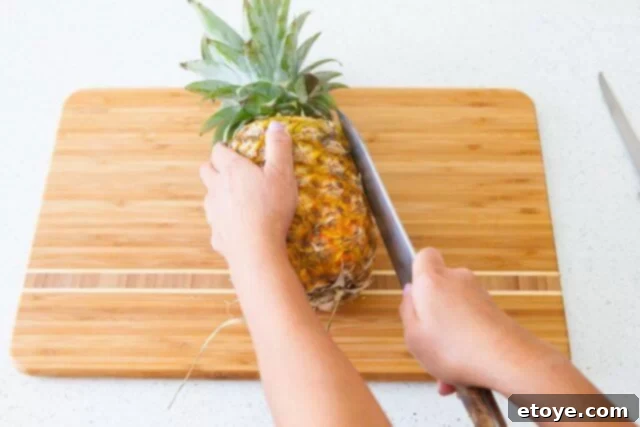
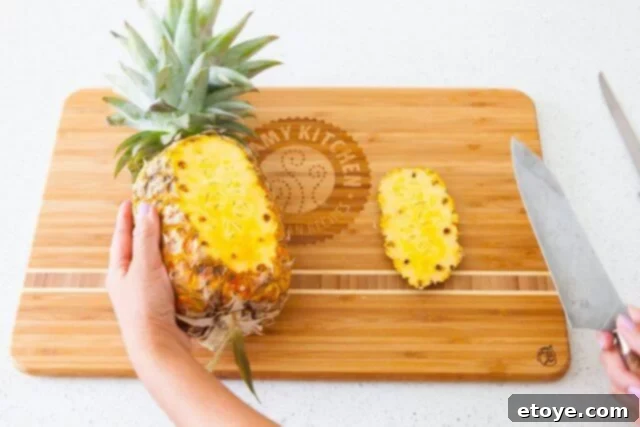
Step 1: Stabilize Your Pineapple Base
First, carefully inspect your whole pineapple. Identify the flattest side of the fruit – this will serve as the stable bottom of your exquisite serving bowl. If your pineapple is overly rounded and prone to wobbling, use a sharp, sturdy knife to make a very thin, horizontal slice off the bottom. This small, precise cut creates a perfectly stable base, preventing your beautiful bowl from tipping over once filled with delicious fried rice. Exercise caution here: slicing too deeply will cut into too much valuable flesh, which could potentially create a leak in your finished bowl. A minimal, level cut is all that’s required to achieve perfect stability.
Step 2: Halve the Pineapple Lengthwise

With your pineapple securely stabilized, carefully cut it in half lengthwise, extending from the leafy crown all the way down to the newly flattened base. As you do this, keep in mind which side you designated as the bottom to ensure your future bowl stands upright without issue. For this recipe, you’ll typically only need one half for your serving bowl; the other half can be reserved for another culinary creation, a refreshing snack, or conveniently used if you decide to double the fried rice recipe for a larger gathering.
Step 3: Score the Inner Edges

Employing a sharp knife, carefully cut along the inner edge of the pineapple flesh, aiming to stay approximately 1/4 inch away from the outer skin. Make sure to execute this cut all the way around the entire perimeter of the pineapple half. A flexible boning knife is particularly well-suited for this step, as its pliability allows you to gracefully follow the natural curve of the pineapple and reach deep into the fruit. It is absolutely crucial to exercise extreme caution here: under no circumstances should you cut through the outer skin or, most critically, through the bottom of the pineapple, as either error would compromise the structural integrity and cause your elegant serving bowl to leak.
Step 4: Isolate the Core

Next, make two parallel cuts along both sides of the fibrous central pineapple core. This strategic cutting will effectively isolate the core section, which is generally too tough and woody to be enjoyable to eat in the fried rice. While you will primarily discard the main core later, it’s a good idea to keep a small, manageable piece handy for a moment, as it might prove surprisingly useful for an ingenious quick fix if any issues arise.
Step 5: Loosen and Scoop Out the Flesh
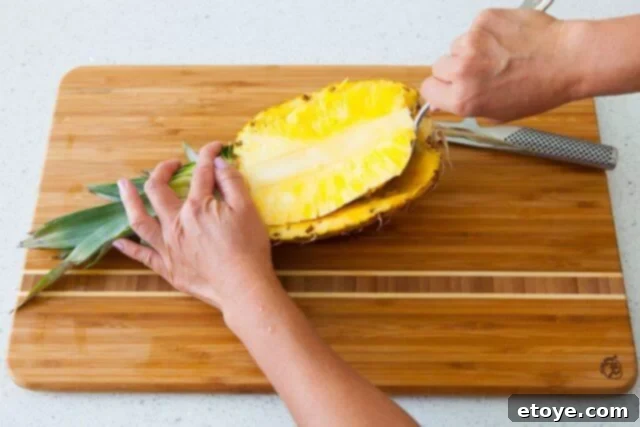

With the edges scored and the core isolated, now use a large sturdy spoon to gently lift and loosen the pineapple flesh. Work your way methodically around the shell, scooping out all the delicious edible fruit. Be meticulous in your efforts, ensuring you extract as much flesh as possible without compromising the structural integrity of the pineapple skin, particularly at the bottom. The ultimate goal is to create a clean, sturdy, and well-formed shell that can confidently hold your fried rice without any leaks or weaknesses.
Step 6: Final Touches and Leak Prevention
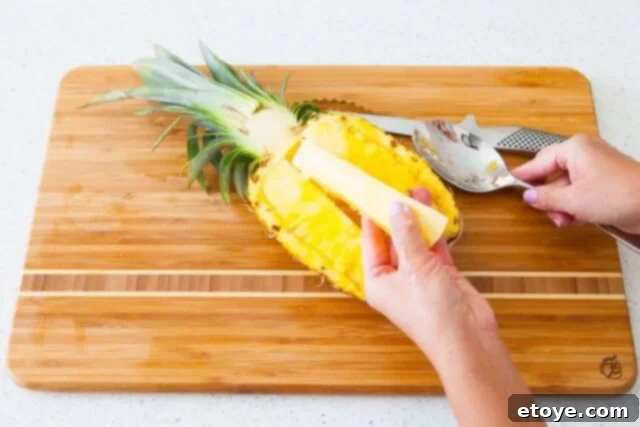
Remove the main core section you isolated earlier and set it aside for a moment. Continue to scoop and carefully scrape out any remaining small bits of flesh from the pineapple shell, always being exceptionally careful not to pierce through the skin. Sometimes, despite our best efforts and precision, a tiny hole might inadvertently appear at the bottom of the shell. Don’t let this minor setback cause concern! Simply take a small, appropriate-sized piece from the pineapple core you just removed and firmly press it into the hole. This acts as a clever, natural plug, effectively preventing any liquid from leaking out when your exquisite fried rice is served.

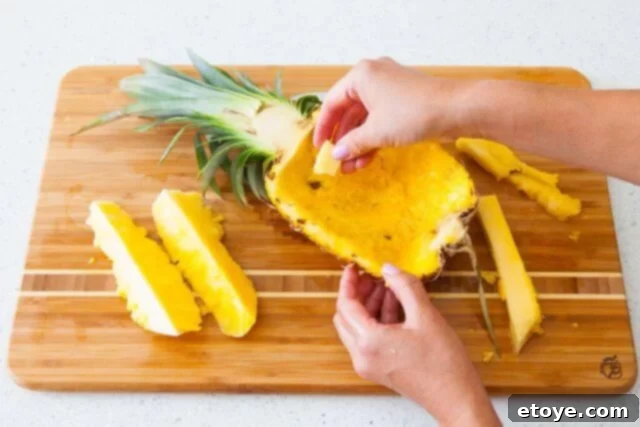
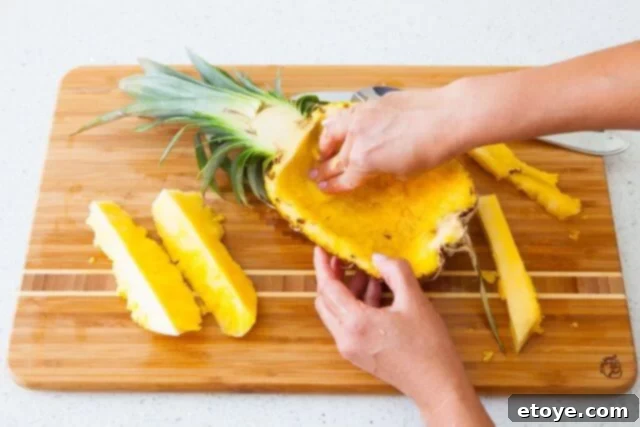
Your magnificent pineapple bowl is now perfectly prepared and ready to be filled with your freshly made Pineapple Fried Rice! Discard any remaining tough core pieces. Take the beautifully scooped-out pineapple flesh and cut it into small, uniform, bite-sized cubes, roughly the size of a dice. We will typically use about 1 1/2 cups of these diced pieces within the fried rice itself. If you desire a more pronounced pineapple flavor, you are welcome to cut up more from the other half, but always remember that an excessive amount of pineapple can sometimes overpower the delicate and nuanced flavors of the rice, chicken, and shrimp. Achieving a harmonious balance is key to creating a truly outstanding and memorable dish.
Recipe Inspiration: A Nod to “Everyday Chinese Cooking”
This delightful Pineapple Fried Rice recipe, which has been carefully refined, draws its original inspiration from “Everyday Chinese Cookbook” by Katie Chin. This cookbook serves as a fantastic resource for exploring authentic Asian flavors in your kitchen. While Katie Chin’s original recipe provided a wonderful and flavorful foundation, we’ve made a few strategic adjustments to further enhance the freshness, texture, and overall depth of flavor. Notably, our version opts for fresh, uncooked chicken and shrimp, which are cooked from scratch to ensure optimal tenderness and taste, rather than utilizing pre-cooked varieties. We firmly believe these thoughtful modifications elevate the dish, allowing the naturally sweet and tangy notes of fresh pineapple to harmonize perfectly with the savory elements, creating an unforgettable meal you’ll be eager to prepare and enjoy time and time again.
Explore More Flavorful Fried Rice Creations
If you’ve thoroughly enjoyed the versatility and comforting appeal of fried rice, then you’re in for a treat! There’s an entire world of exciting variations waiting to be discovered. Each recipe below offers a unique and delicious twist on this beloved classic, perfect for transforming everyday leftovers into a gourmet meal or simply trying something wonderfully new.
- Cauliflower Fried “Rice” with Kale & ChickenSeeking a delicious low-carb alternative? This ingenious and healthy recipe ingeniously utilizes grated cauliflower as a flavorful substitute for traditional rice, generously packed with nutritious kale and tender chicken for a satisfying and complete meal that doesn’t compromise on taste.
- Classic Chicken Fried Rice RecipeA timeless and universally loved favorite, this recipe masterfully focuses on achieving perfectly cooked chicken pieces and distinct, well-separated rice grains, delivering that comforting, authentic Chinese takeout experience right in the convenience of your own home kitchen.
- Bold & Tangy Kimchi Fried Rice RecipeInfuse a vibrant, zesty, and spicy kick into your meal with this exciting Korean-inspired Kimchi Fried Rice. It prominently features fermented kimchi for a unique and irresistible umami depth that is both comforting and exhilarating, perfect for an adventurous palate.
- Savory Shrimp Fried Rice RecipeFor devoted seafood enthusiasts, this delectable Shrimp Fried Rice recipe prominently highlights succulent, perfectly cooked shrimp, harmoniously combined with a colorful medley of fresh vegetables and expertly seasoned rice for a truly satisfying dish that’s quick to prepare.
Pineapple Fried Rice Recipe
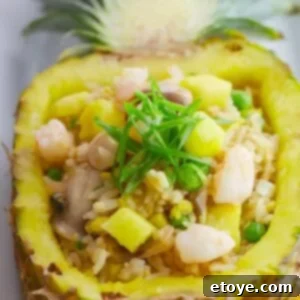
Pineapple Fried Rice Recipe
By Jaden
This Pineapple Fried Rice recipe, thoughtfully adapted from Katie Chin’s “Everyday Chinese Cookbook,” yields a wonderfully balanced and intensely flavorful dish. For an impressive and memorable presentation, we recommend utilizing half of a whole pineapple, meticulously cut lengthwise, as a stunning serving bowl. If crafting a pineapple bowl isn’t your preference or time is short, simply use about 1 1/2 cups of freshly diced pineapple flesh. For those seeking a healthier option, feel free to substitute white rice with brown rice in this recipe.
Rating: 4.67 out of 5 stars from 6 votes
Pin Recipe
15 mins
10 mins
25 mins
Main Course
Thai
4 people
394 kcal
Ingredients
- 1 whole pineapple (for serving bowl and diced fruit)
- 2 large eggs, slightly beaten
- Salt & freshly ground black pepper, to taste
- 4 ounces chicken, boneless and skinless, cut into bite-sized cubes
- 4 ounces raw shrimp, peeled, deveined, and cut into bite-sized cubes
- 3 tablespoons cooking oil, such as vegetable or canola, divided
- 2 stalks green onion, thinly chopped
- 1 teaspoon grated or finely minced fresh ginger
- 3 cups cold, day-old leftover rice (absolutely crucial for fluffy results!)
- 2 tablespoons soy sauce (low-sodium preferred)
- 1/2 teaspoon Asian sesame oil
- 6 white button mushrooms, thinly sliced (or substitute with shiitake mushrooms for deeper flavor)
- 1/2 cup fresh or thoroughly thawed frozen peas
Instructions
- Begin by carefully preparing the whole pineapple according to the detailed step-by-step photos and instructions provided earlier in this post. Once you have successfully hollowed out the pineapple half to create your serving bowl, take the scooped-out pineapple flesh and cut it into small, uniform dice. You will need approximately 1 1/2 cups of these diced pieces for the recipe. Reserve any remaining unused pineapple for another culinary purpose.
- In a small mixing bowl, season the chicken cubes with a pinch of salt, a dash of freshly ground black pepper, and a few drops of Asian sesame oil. In a separate, equally small bowl, season the shrimp similarly. Before proceeding to cooking, it is absolutely crucial to wet your hands lightly and gently separate the grains of your cold, cooked, and chilled rice to prevent any clumping during stir-frying.
- Heat a wok or a large, sturdy sauté pan over medium-high heat until it is thoroughly hot. Swirl in just 1 tablespoon of cooking oil. Pour in the lightly beaten eggs and scramble them quickly, cooking only until they are just set but still slightly moist. Promptly transfer the cooked eggs to a clean plate and set aside.
- Wipe the wok or pan clean with a paper towel to remove any egg residue. Return the wok to high heat. Once it is smoking hot, swirl in another 1 tablespoon of cooking oil. Add the seasoned chicken pieces and stir-fry them vigorously for about 2 minutes, or until they are lightly browned and almost cooked through, but still showing a slight hint of pink inside. Immediately add the seasoned shrimp to the wok with the chicken and continue to stir-fry together for approximately 1 minute, or until the shrimp turns vibrant pink and opaque and the chicken is fully cooked. Transfer the cooked chicken and shrimp to the same plate as the scrambled eggs and set aside.
- Return the now-empty wok to the stove, maintaining high heat. Add the final 1 tablespoon of cooking oil. Once hot, add the finely chopped green onions and the minced fresh ginger. Stir-fry for a quick 15 seconds until they become intensely fragrant.
- Add the meticulously separated cold rice and the thinly sliced mushrooms to the wok. Stir-fry everything vigorously for approximately 2 minutes, ensuring each grain of rice is thoroughly heated to its core and lightly toasted. Pour in the soy sauce and the remaining Asian sesame oil, then give it a good toss to ensure all components are evenly coated and flavored.
- Finally, reintroduce the reserved cooked egg, chicken, and shrimp mixture back into the wok. Incorporate the diced pineapple cubes and the fresh or thawed peas. Toss all the ingredients together exceptionally well and continue to cook for an additional 2 minutes, allowing all the ingredients to heat through and their wonderful flavors to meld harmoniously. Taste the fried rice and adjust the seasoning with additional soy sauce or black pepper as desired. Serve immediately, ideally presented in your beautifully prepared pineapple bowl for a truly unforgettable dining experience!
Nutrition Facts (per serving)
Approximate values per serving (based on 4 servings):
- Calories: 394 kcal
- Carbohydrates: 37g
- Protein: 19g
- Fat: 18g
- Saturated Fat: 2g
- Cholesterol: 174mg
- Sodium: 779mg
- Potassium: 366mg
- Fiber: 2g
- Sugar: 6g
- Vitamin A: 380 IU
- Vitamin C: 30.4mg
- Calcium: 81mg
- Iron: 2.4mg
Keywords
fried rice, pineapple, Thai fried rice, chicken shrimp fried rice, fluffy fried rice, homemade fried rice, stir-fry recipe, quick dinner, Asian cuisine
Tried this recipe?
We’d absolutely love to hear about your experience! Please let us know how it turned out for you by leaving a comment below. Your feedback helps us and other home cooks.
